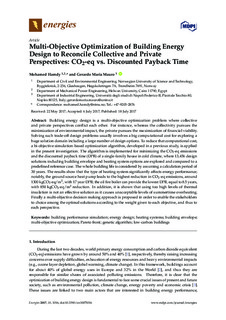| dc.contributor.author | Hamdy, Mohamed | |
| dc.contributor.author | Mauro, Gerardo Maria | |
| dc.date.accessioned | 2017-10-25T14:58:32Z | |
| dc.date.available | 2017-10-25T14:58:32Z | |
| dc.date.created | 2017-10-17T17:16:59Z | |
| dc.date.issued | 2017 | |
| dc.identifier.citation | Energies. 2017, 10 (7), . | nb_NO |
| dc.identifier.issn | 1996-1073 | |
| dc.identifier.uri | http://hdl.handle.net/11250/2462213 | |
| dc.description.abstract | Building energy design is a multi-objective optimization problem where collective and private perspectives conflict each other. For instance, whereas the collectivity pursues the minimization of environmental impact, the private pursues the maximization of financial viability. Solving such trade-off design problems usually involves a big computational cost for exploring a huge solution domain including a large number of design options. To reduce that computational cost, a bi-objective simulation-based optimization algorithm, developed in a previous study, is applied in the present investigation. The algorithm is implemented for minimizing the CO2-eq emissions and the discounted payback time (DPB) of a single-family house in cold climate, where 13,456 design solutions including building envelope and heating system options are explored and compared to a predefined reference case. The whole building life is considered by assuming a calculation period of 30 years. The results show that the type of heating system significantly affects energy performance; notably, the ground source heat pump leads to the highest reduction in CO2-eq emissions, around 1300 kgCO2-eq/m2, with 17 year DPB; the oil fire boiler can provide the lowest DPB, equal to 8.5 years, with 850 kgCO2-eq/m2 reduction. In addition, it is shown that using too high levels of thermal insulation is not an effective solution as it causes unacceptable levels of summertime overheating. Finally a multi-objective decision making approach is proposed in order to enable the stakeholders to choice among the optimal solutions according to the weight given to each objective, and thus to each perspective. | nb_NO |
| dc.language.iso | eng | nb_NO |
| dc.publisher | MDPI | nb_NO |
| dc.rights | Navngivelse 4.0 Internasjonal | * |
| dc.rights.uri | http://creativecommons.org/licenses/by/4.0/deed.no | * |
| dc.title | Multi-Objective Optimization of Building Energy Design to Reconcile Collective and Private Perspectives: CO2-eq vs. Discounted Payback Time | nb_NO |
| dc.type | Journal article | nb_NO |
| dc.type | Peer reviewed | nb_NO |
| dc.description.version | publishedVersion | nb_NO |
| dc.source.pagenumber | 26 | nb_NO |
| dc.source.volume | 10 | nb_NO |
| dc.source.journal | Energies | nb_NO |
| dc.source.issue | 7 | nb_NO |
| dc.identifier.doi | 10.3390/en10071016 | |
| dc.identifier.cristin | 1505353 | |
| dc.description.localcode | (c) 2017 by the authors. This is an open access article distributed under the Creative Commons Attribution License which permits unrestricted use, distribution, and reproduction in any medium, provided the original work is properly cited. (CC BY 4.0). | nb_NO |
| cristin.unitcode | 194,64,91,0 | |
| cristin.unitname | Institutt for bygg- og miljøteknikk | |
| cristin.ispublished | true | |
| cristin.fulltext | original | |
| cristin.qualitycode | 1 | |

